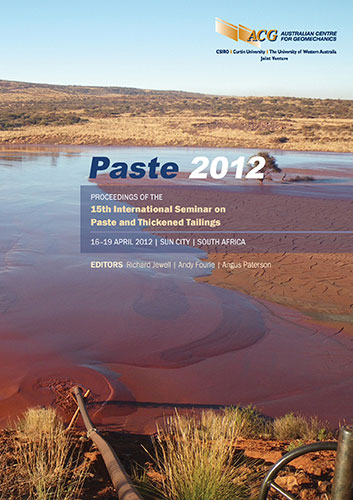A new approach to fine solids dewatering

|
Authors: Lowe, C St J Paper is not available for download Contact Us |
DOI https://doi.org/10.36487/ACG_rep/1263_12_Lowe
Cite As:
Lowe, C St J 2012, 'A new approach to fine solids dewatering', in R Jewell, AB Fourie & A Paterson (eds), Paste 2012: Proceedings of the 15th International Seminar on Paste and Thickened Tailings, Australian Centre for Geomechanics, Perth, pp. 129-140, https://doi.org/10.36487/ACG_rep/1263_12_Lowe
Abstract:
Weir Minerals – Linatex has developed a new approach to the dewatering of fine solids, particularly mine and process plant tailings and wastes. The Weir process, patented in 2009, uses standard process equipment in a standard flow sheet, but applies this approach to materials previously thought to be too fine to be dewatered with this type of equipment. The process can be applied to a wide range of materials, making lower moisture products that can be re-used elsewhere or sent to disposal. It has already been tested successfully on a small scale in Australia on coal fines, zinc mine tailings, red mud, iron ore tails, and copper/gold tailings. The principal factors affecting the solids recovery have been established as: The key factors affecting the % solids in the dewatered product have been determined to be: Eight plants ranging in size from 3 to 40 t/h have been sold to a range of customers in China, for coal and iron ore tailings treatment. Australia has one plant, a small unit rated at 30 t/h of sand fines, and has recently completed test work on iron ore tailings for a dewatering plant rated at 135 t/h. Additional tests are under way with clients around Australia, to demonstrate the capabilities of this process on specific applications and to provide confirmation that materials can be processed successfully, before moving on to larger scale tests or full size plants. The advantages of the Weir process include – lower moisture in products, uses proven equipment, lower capital and operating costs, lower maintenance costs, reduced power consumption, compact footprint, can be used in parallel or in series with existing equipment, modular design to facilitate redundancy or expansion, efficient water recovery and simpler water management, reduced cement in backfill mixes, smaller tailings disposal footprint, reduced earthworks requirements, much lower seepage losses, more stable tailings mass, progressive site rehabilitation, reduced impact on local wildlife, reduced risk of dam wall failure, and reduced environmental monitoring and compliance costs.
© Copyright 2025, Australian Centre for Geomechanics (ACG), The University of Western Australia. All rights reserved.
View copyright/legal information
Please direct any queries or error reports to repository-acg@uwa.edu.au
View copyright/legal information
Please direct any queries or error reports to repository-acg@uwa.edu.au